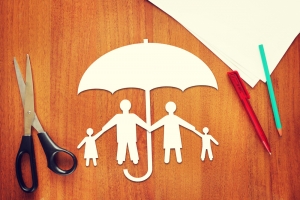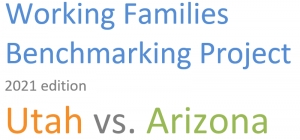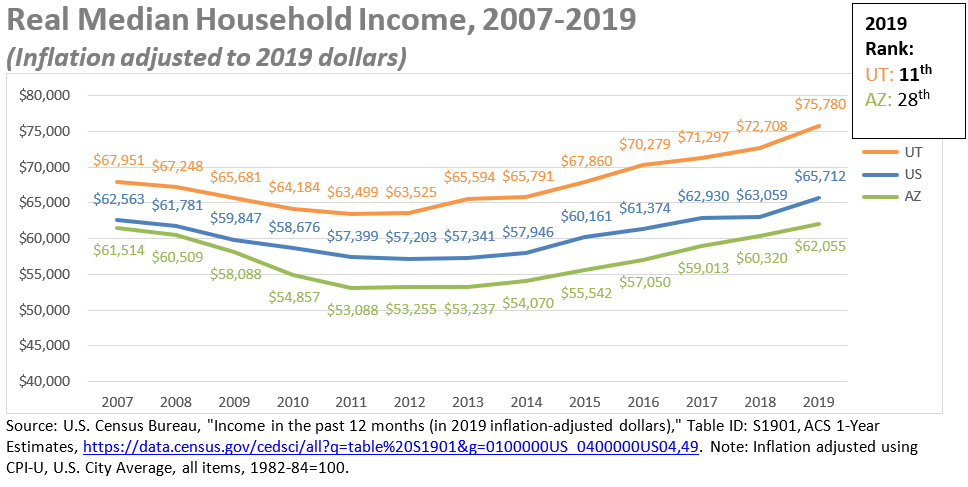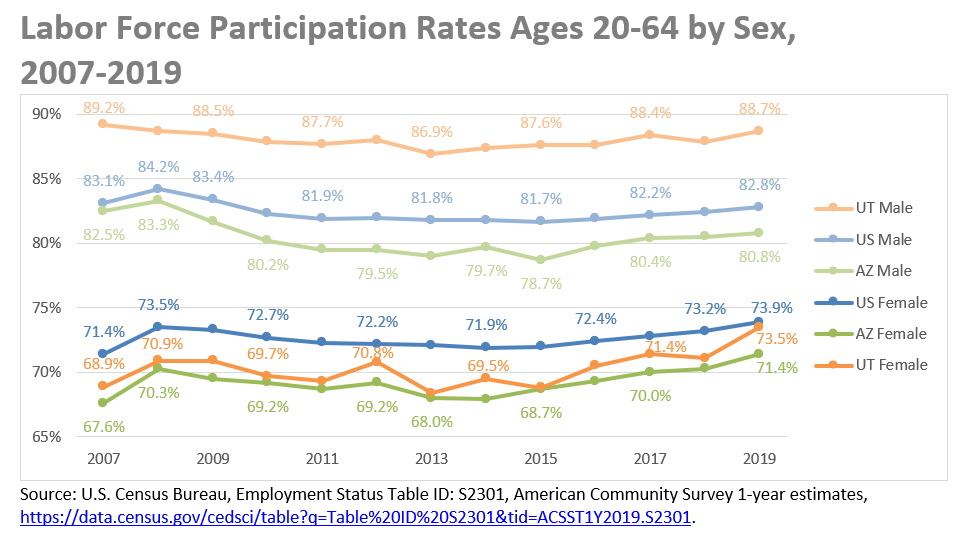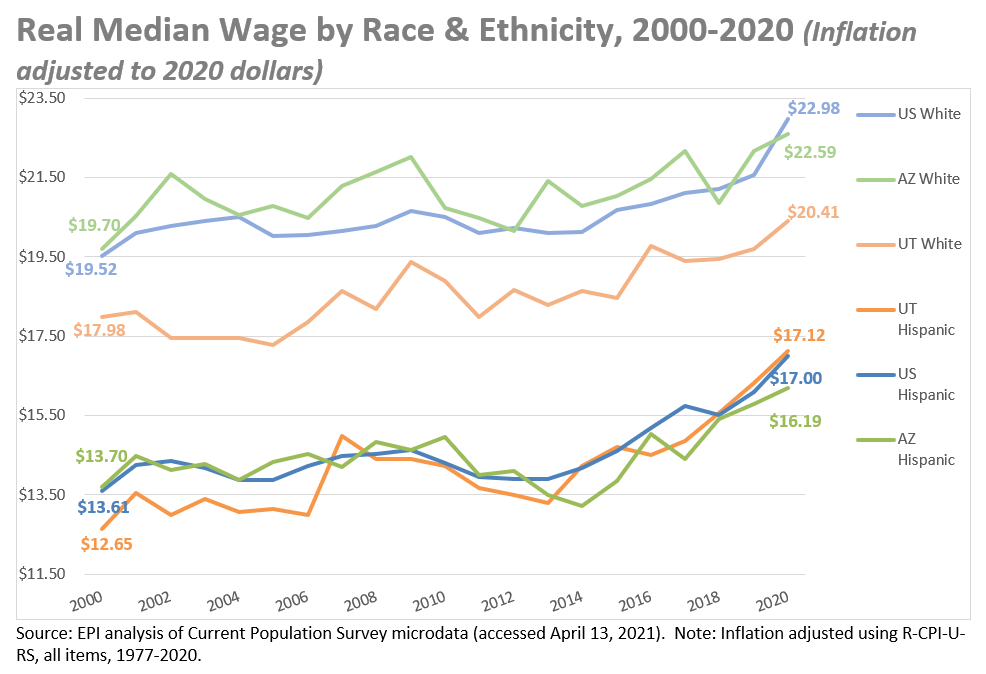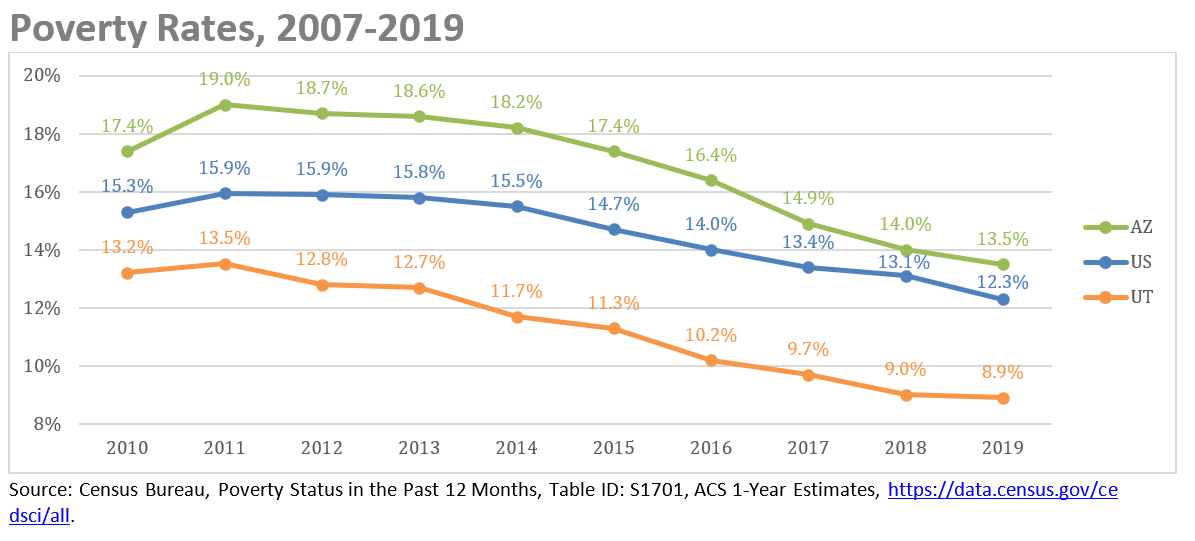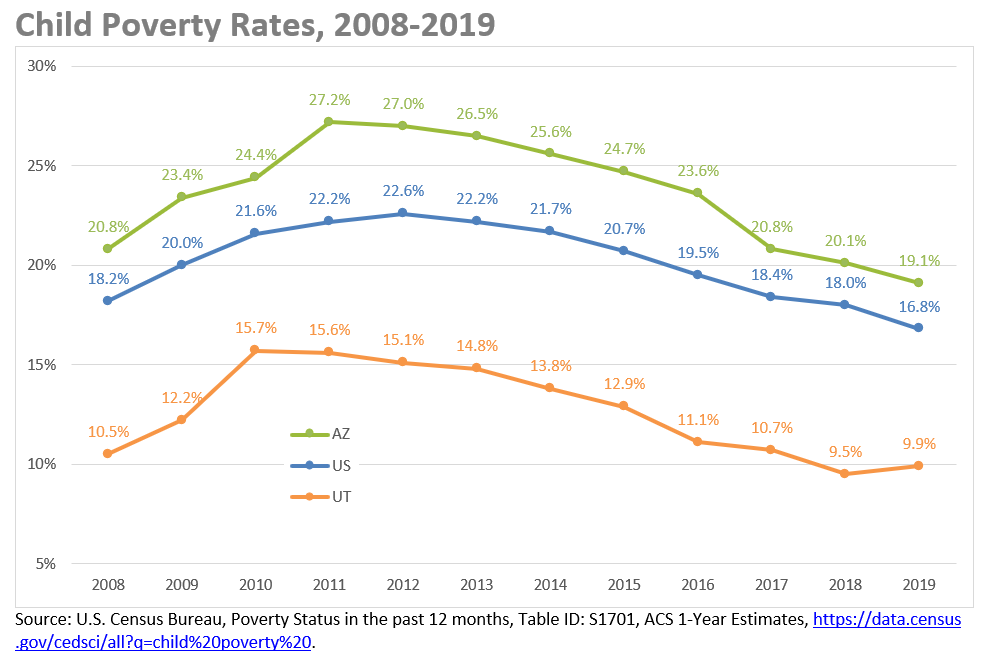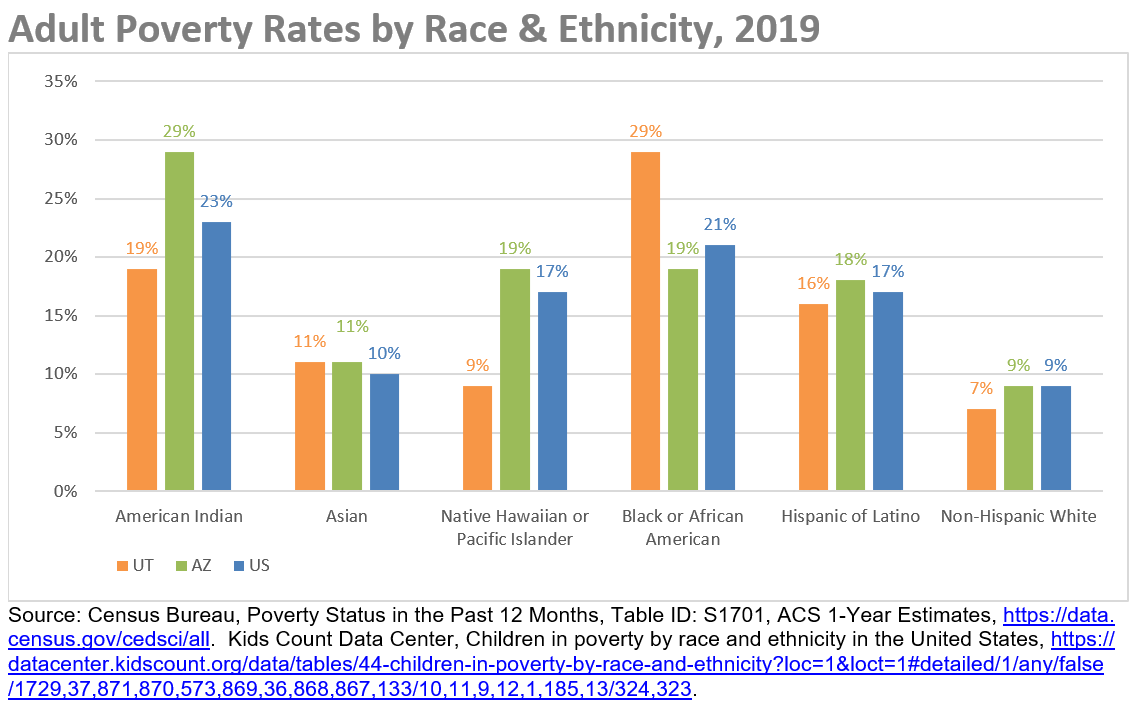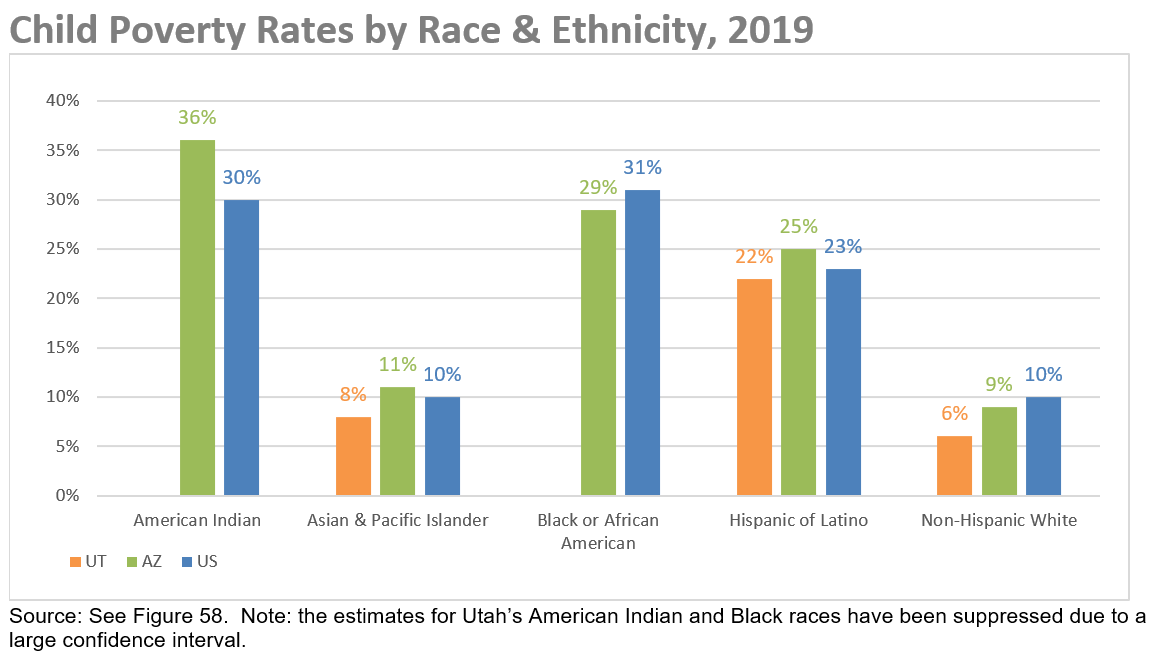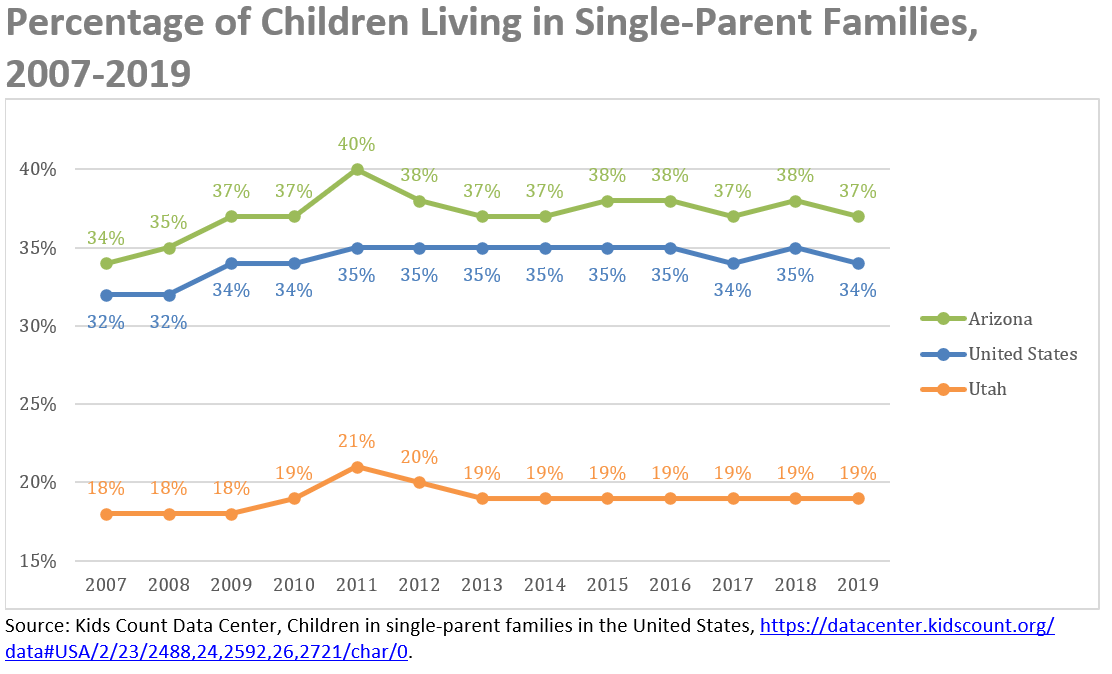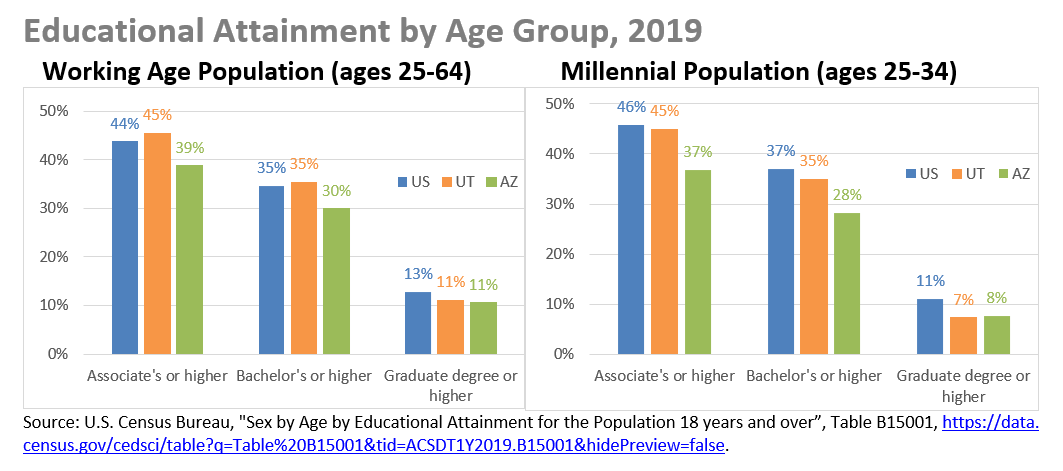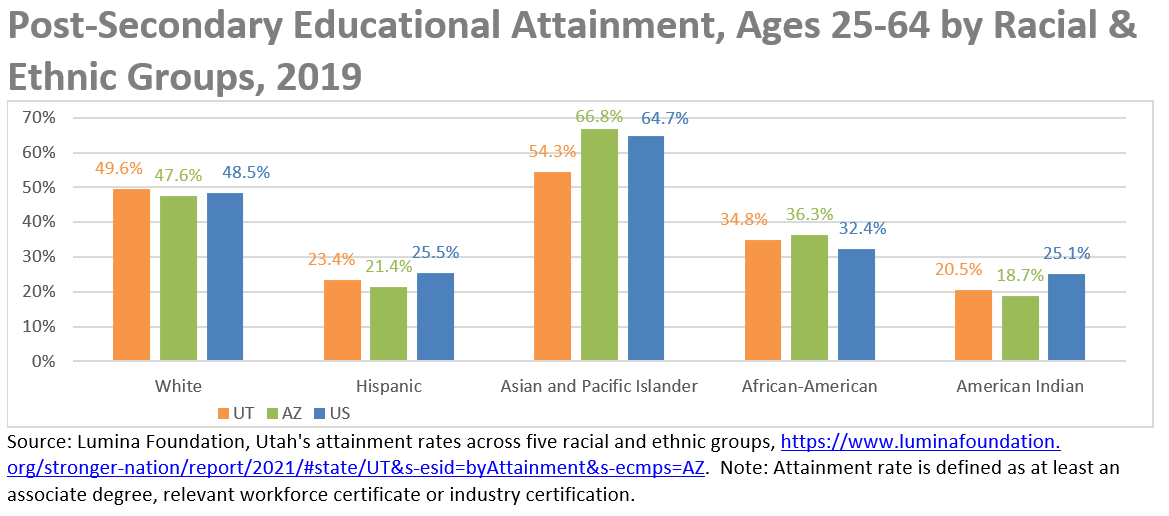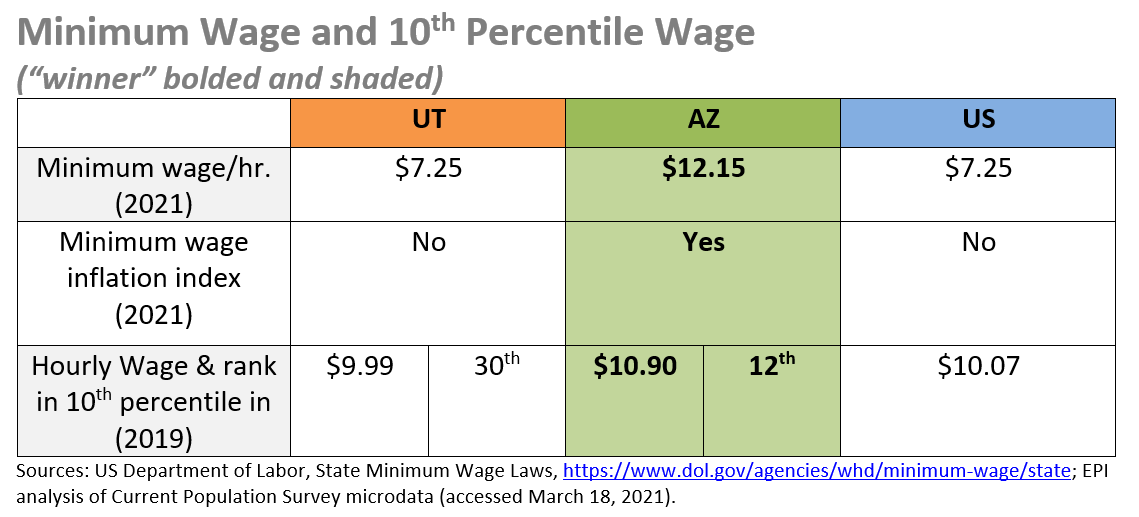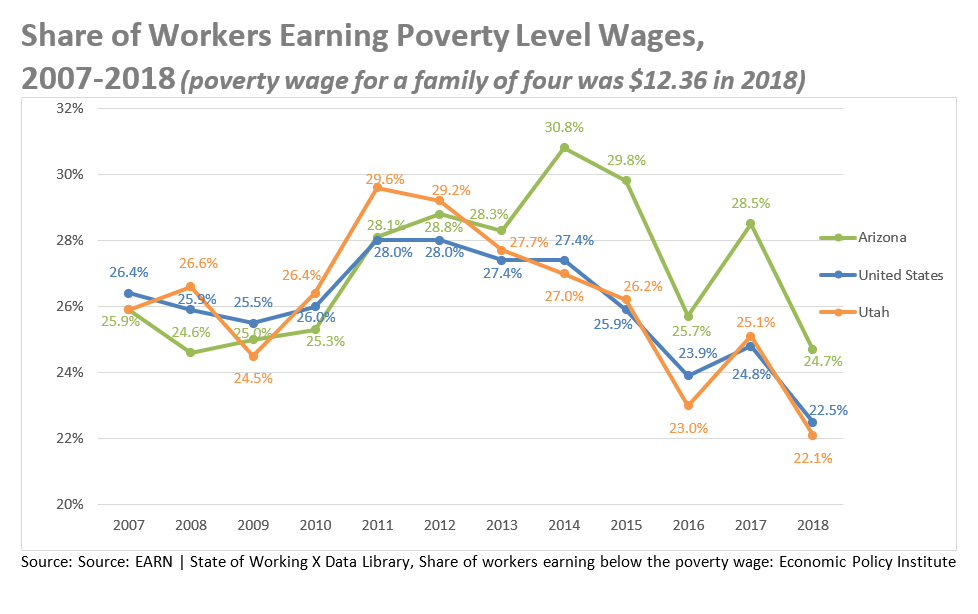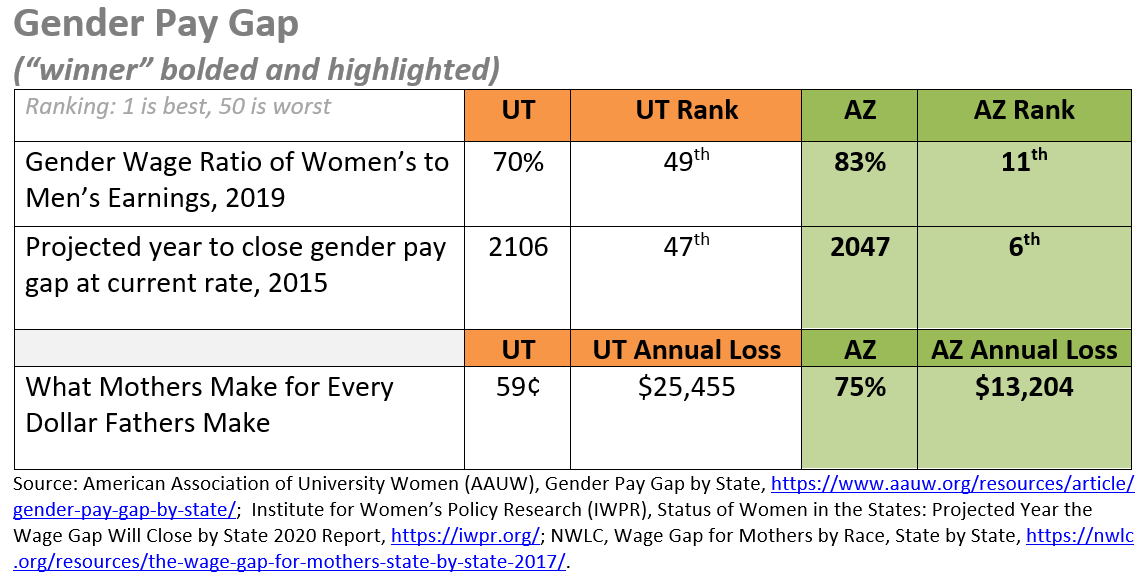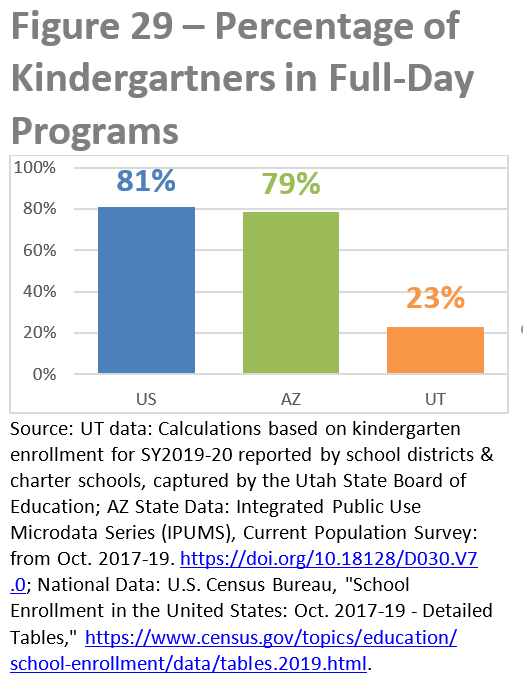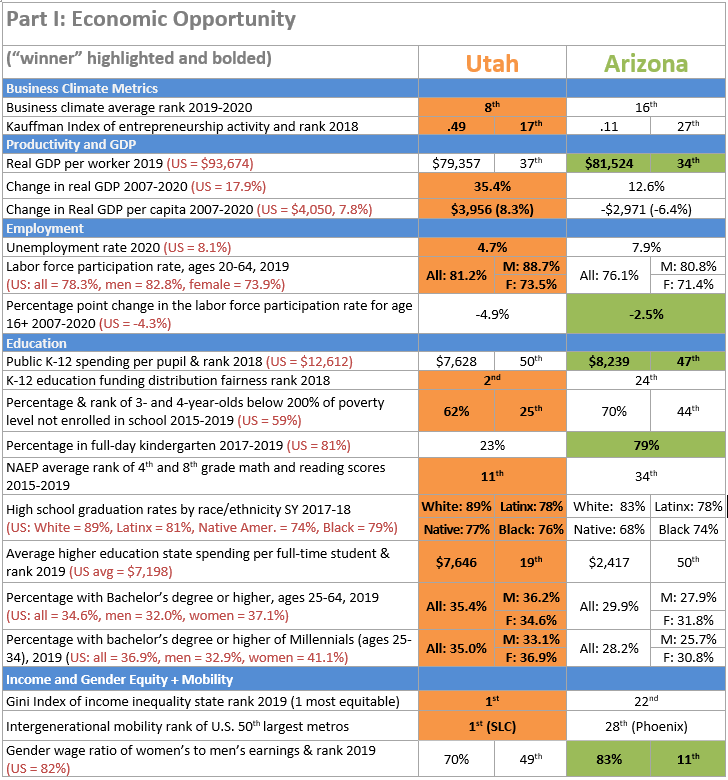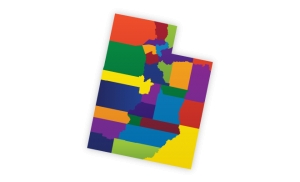Medicaid
Proposed Changes to Utah Medicaid: What You Should Know and Why Your Comments Are Critical!
Utah is not getting the expansion we voted for… Utah Medicaid is facing serious threats
The Legislature’s bill rolling back Proposition 3 includes several harmful changes to Medicaid. The bill proposes to:
- Create additional reporting requirements for enrollees
- Limit the number of people who can enroll in Medicaid
- Make it harder for individuals to access care
These changes would lead to cuts for Utahns’ healthcare and coverage and will put the Utah Medicaid program at risk.
Your Comments Are Needed!
The Utah Department of Health – at the direction of the Governor and Legislature — have released a proposal to make these harmful changes to Utah Medicaid...again.
Comments are the best way to defeat these harmful proposed changes to Utah Medicaid and get us back to the straightforward, full Medicaid expansion you voted for. Without restrictions or barriers to care. The federal and state government are required to consider all comments; if they don’t, then the proposal can be overturned through legal action. Comments are the reason Kentucky’s Medicaid proposal was stopped in its tracks.
Submit your comments here. Thank you for your continued action!
But wait! Even with these confusing changes, many more people are eligible for Medicaid now because Utah has partially expanded Medicaid. If you or someone you know applied before and were rejected, it is a good time to check again. Find out if you qualify for coverage here!
Learn More:
Confused? Need a refresher on Utah's messy path to full Medicaid expansion. Check out this overview from our friends at the Utah Health Policy Project.
How did Proposition 3, a.k.a voter-approved full Medicaid expansion, compare to the Legislature’s partial Medicaid expansion bill, aka SB 96? Learn more.
Voices for Utah Children’s Response to CMS Approval of Utah’s Partial Medicaid Expansion
Voices for Utah Children’s Response to CMS Approval of Utah’s Partial Medicaid Expansion
Voices for Utah Children is dismayed by the Centers for Medicare & Medicaid (CMS)’s decision today. While we are encouraged that some Utahns will be able to access needed care, too many Utahns will still be left without health coverage.
In November of last year, Utah voters passed a plan to close the coverage gap and fully expand Medicaid up to 138% of the federal poverty level, bringing federal tax dollars home to Utah. However, during the 2019 Legislative Session, the Utah Legislature rejected the will of voters and rolled back that plan, including the federal funds that came with it, despite outcries from the public, providers, patients, community leaders and many of its own legislators.
Today CMS chose to approve the Legislature’s more expensive partial Medicaid expansion plan -- a plan that will cost Utah taxpayers more, cover fewer people, impose harmful barriers to care and caps on enrollment for low-income Utahns. This plan creates a dangerous precedent for our Medicaid program and gambles with Utah taxpayers’ hard-earned dollars.
Of particular concern in this waiver:
- It doesn’t add up. The waiver forces Utah to spend more of its own money to provide health coverage to fewer people. Utah will only receive $2.30 in federal funds for every state dollar spent on Medicaid instead of $9.30 in federal funds for every state dollar spent under full Medicaid expansion.
- It’s dangerous. Medicaid is designed to help in times of crisis, allowing states to respond to public health emergencies, natural disasters, and to provide support during economic downturns. Limiting the number of people who can enroll in the Medicaid program could leave many vulnerable Utahns shut out from health coverage when they need it most.
- It doesn’t work. Research shows that work reporting requirements do nothing to help people find work, but instead create unnecessary red-tape and program complexities that result in hard-working, qualified Utahns losing their health coverage.
CMS’ approval of this partial expansion waiver will leave many unable to access affordable coverage and creates more health care obstacles for both parents and children. When parents’ coverage is in jeopardy, kids’ coverage is also at risk. While Voices for Utah Children is encouraged that some Utahns will get coverage starting on April 1, this plan undermines voter-approved full Medicaid expansion. Utahns deserve better; all Utahns deserve access to affordable health coverage without caps, unnecessary red-tape, and stumbling blocks.
For more information please reach out to Jessie Mandle, the Senior Health Policy Analyst at .
####
71,000 Utah Kids Still Without Health Insurance… Why?
This Legislative Session, we have heard a lot of thoughtful, important discussion around children’s access to health coverage and care, including needed mental health care. Health insurance helps children connect with affordable care, yet thousands of Utah children are not enrolling in coverage. Utah has the highest rate of kids currently eligible for health insurance, but not enrolled.
Following the Session, Voices for Utah Children will be releasing an in-depth “State of Children’s Care” report that reviews kids’ coverage and care across the state. Here’s a preview look at some reasons why Utah kids are still uninsured…
- Uninsured Parents= kids more likely to be uninsured: Thousands of parents have been left without have health insurance for too long. On April 1st, parents with incomes between 60-100% of the federal poverty level will be able to enroll in Medicaid coverage. After the passage of Proposition 3 and then Senate Bill 96, there is a lot of confusion among parents around what affordable health care options are still available and the new requirements to getting care. It’s important that up-to-date information is provided to families, so that eligible parents can begin enrolling on April 1st. Research shows that covering parents helps kids.
- Keeping kids covered after they enroll: Once kids get enrolled, we need to help them stay covered. Kids can lose coverage because of administrative error, a small change in parents’ income or an employer’s failure to return requested information on behalf of the parent.
- Misinformation and lack of outreach: Many families are confused about what types of affordable options are available to them. Unfortunately, statewide there is a significant lack of outreach funding to help families learn about options and dispel confusion.
- Fear: The federal administration has contributed to a climate of fear that is causing many immigrant families to not enroll, or dis-enroll, their children from Medicaid or CHIP, for fear of reprisal. The majority of children with immigrant parents are eligible for coverage but are not enrolling. We need to counter this climate of fear, create a welcoming environment for new Americans and fight the misinformation of using public benefits.
- Coverage disparities: Utah has one of the highest rates of uninsured Latino/Hispanic children. Alongside fighting the climate of fear for immigrant families, we must also continue to outreach to communities and support families who may not enroll alone.
Unfortunately, as we reported last year, the rate of uninsured Utah children is trending in the wrong direction. For the first time in almost ten years, we saw a troubling rise in the number of uninsured children in our state. Voices for Utah Children is currently working to increase coverage and care for all children with our 100% Kids Coverage Campaign. Let’s work together to help all Utah kids get the coverage and care they need to be healthy and thrive.
Immigrant Families On Access To Health Care
Immigrant Families on Health Coverage
Thanks to Centro de la Family, the Consulate of Mexico in Salt Lake, Holy Cross Ministries, and Utah Health Policy Project, we were able to survey 34 immigrant families about health care, access to health insurance, what having health insurance or not has meant for them.
The immigrant families surveyed range in location and statuses many families live in mixed immigration statuses from undocumented, legal permanent residents, and U.S. citizens.
From all the surveys, one thing was clear: having access to quality health insurance such as CHIP or Medicaid has made a difference for these families in terms of health, overall wellbeing, and financial security.
“It has meant a lot especially because I have a son with disabilities and a lot of doctor’s appointments.”
“[Medicaid/CHIP] is great, it has made us feel like my children are protected.”
“It brings me peace to know that when my children need medical attention or have an emergency, I have place to take them without being overwhelmed by billing”
“My children have health insurance and I feel good with it because whatever happens I can take them to the doctors.”
These quotes were taken directly from mothers who took the survey and were able to take their children to receive the necessary wellness checks throughout the year for their children and felt the safety net that CHIP and Medicaid provided. This safety net has allowed these families to spend less on health care, access the services they need, and not feel overwhelmed by the health care system. Many of them talked about a feeling of “tranquility” from having access to
For the families that were unable to have access to health insurance the amounts they owed ranged from owing $300-$5,000 in medical bills. 6 families reported their sick children got other family members or other classmates sick, 5 said they caused absences in school, and 4 of them also said an adult at home missed days of work and had to stay home.
One mother said, “Having health insurance for my children has been of great importance to me, I have felt happy to have their physical checks done and my children are very healthy.”
Another mother said, “It helped us during the time that my husband was unable to work, and we had low resources, mi children went to the emergency room and were able to get treatment.”
One mother also talked about the benefits of having health insurance meant her family and her were able to understand the benefits that are much greater than spending less on health care: “I learned that having regular physical and dental check ups that are covered by Medicaid you can reduce the risk of developing serious illnesses and that has helped my family and children a lot.“
Overall the theme remained the same, having health insurance such as Medicaid and CHIP provided relief for all the families that were surveyed. Each of them had different concerns but most of their main concerns were the wellbeing of their children and having the means to pay for their wellness checks. While there is still a climate of fear that surrounds immigrant families, they all had an understanding of the importance of health care and health coverage. Thanks to these vital programs, families can move forward, take care of their medical needs, and take care of their families. With our 100% Kids Coverage Campaign we are hoping to improve coverage and care for all families in Utah! If you would like more information about our campaign, please click here or email !
Together we can work towards 100% Kids Covered in Utah!
A Conversation (Focus Group) with Former Undocumented Children
If you would like to read this blog post offline, please scroll to the bottom to download a copy of the PDF version!
During the third week of November, we held a focus group with Dreamers and children of immigrant parents to discuss what health care looked like while they were growing up. As they undocumented children, children in mixed status families, and in immigrant families they shared the same concerns and understanding of what it meant to obtain health care.
The similarities we heard were:
- using community health centers and learning their limitations
- mistrusting systemic entities like hospitals and government
- the lack of understanding of health care and learning it as adults
- cultural competency from health care professionals
- how care was accessed
Community Health Clinics
One individual mentioned a story of growing up with migraines that touched on the importance of all these pieces especially from obtaining care from local community clinics. She grew up as an undocumented immigrant child and is now a Permanent Resident. She said:
I grew up with migraines and I had them since I was 7. I never knew what they were, and my mom didn’t know what they were either. They would put an onion to my head [as a home remedy to help alleviate the pain]. I didn’t have a primary doctor, and I remember going in a couple of times each time and told them I had pain but, they would give me over the counter Advil. I remember looking at the TV and a commercial about migraines [came on] and they were listing the symptoms like sensitivity to light, the nausea, the severe pain, and I remember going “That’s what I have!” Basically, diagnosing myself and the next time I went to the doctor I told him I was having migraines, but he didn’t prescribe anything but, it really wasn’t until last year that I got an actual prescription because of the stigma around prescription drugs.
Mistrust and Fear
One of the most important pieces highlighted at the end was this notion that “I still have that message engrained in my brain not to trust the system.” A mistrust within immigrant families to seek health care services because of fear. “And fear of course we are still undocumented so its scary to put your name out there…” ‘A[fear] now and since when we were kids. It still hasn’t gone away because I’m still undocumented it isn’t as scary, but [the fear] still doesn’t go away.” Given the climate of fear and hostility that has grown within this last year, these feelings continue to linger with these young adults even as they have integrated into Utah and all have either DACA, Legal Permanent Residency, or are U.S. citizens. This is especially important because of the new Public Charge Rule that may drastically change the way immigrant families seek services, scaring them away from public benefits that they qualify for and fearing that their information may be used against them.
Mistrusting the health care system and giving information was also a major concerned discussed by all participants as one highlighted as they discussed the barriers they faced when their parents sought out services for them as children, “If we don’t have someone we can trust (neighbor, family, friend) we don’t have that accessibility or knowing where to get that information [then we won’t seek health care services]”
Understanding Healthcare
An interesting point was mentioned by a participant about what it has meant to have grown up without health insurance now as an adult. She said, “You don’t know who to really talk to and because you grew up not thinking it was necessary, it really does impact you as an adult” She mentioned feeling like there’s a “big gap of knowledge” that she has been trying to fill now as adult navigating health care. Another person mentioned, “I do think it’s funny that my first physical was at 26” because she is DACAmented and obtained private health insurance from her wife’s plan. This is consistent to other trends that emphasize about health care coverage during childhood is important and just as important is having health care coverage for parents, it is also good for children and the “welcome mat” effect.
Another participant mentioned she worked at a community clinic now and continues to see a trend in the misunderstanding and lack of knowledge when it comes to health care for Latino and immigrant families. She said, most families, call the clinic their medical and dental home even if it might not be. There is a gap between understanding that having a medical home means having the same head doctor every time.
Cultural Competency
The cultural competency piece was important to highlight, because health coverage is only the first step to filling the gaps for health care in Utah. One participant mentioned that “[it] doesn’t feel like a welcoming place” even now as adults” and “frustration with the cultural knowledge of health care providers where they make assumptions based on my background.” Even as adults many of these feelings still linger from childhood and now that they understand, are much better able to advocate for themselves within the healthcare system.
How care was accessed
A reoccurring theme throughout the conversation was the amount of times “our moms were our doctors. Where many of them recall their mothers giving them traditional home remedies and not taking medications until necessary. The six participants mentioned they grew up without a head doctor and without regular wellness check-ups unless they were done within a school setting.
100% Kids Coverage Campaign
Each of the six participants gave so many examples of what it was like growing up without health insurance and the barriers they continue to face today because they didn’t grow up understanding the importance of health care with regular check-ups, how to use insurance, and navigating health care in places that don’t always feel welcome.
This focus group gave insight on the difference that health insurance would have made for each of them as children. We hope that more children can access care with our 100% Kids Coverage Campaign. Join us to make sure more young people can access the care they need and can grow up to be the thriving adults they are meant to be.
Ciriac Alvarez Valle
Health Policy and Community Engagement Fellow
Voices for Utah Children
100% Kids Covered: Patricia and Sara the Dreamers
Patricia and her family moved to Salt Lake City, Utah when she was fifteen after living in Texas for a couple of years. She attended West High School and is now an undergraduate at the University of Utah. She and her sister are two of thousands of undocumented immigrant youth living in our state with a lack of access to health care.
She told me, “Health is the most important. If we do not have health, we do not have anything.”
As she attended high school, she was not able to get her regular health care checks. This year was the first time she became ill. She got food poising for two weeks and couldn’t attend her classes for a week at the University of Utah. Her mother ended up taking time off work to take her to the emergency room. This wasn’t the first time they needed to take someone in their family to the emergency room.
About three years ago, her younger sister, Sara, got a urinary track infection that became a life or death situation. They rushed to the emergency room because the infection had spread to her kidneys. Her mother took of a couple of days off work to be with her. Sara also missed days at school because of this. They racked up over $4,600 in medical bills because of this; bills that they are still paying off.
Fortunately, their youngest brother qualified for CHIP. He has been able to attend his wellness checks, stay up to date with his vaccinations, and when he needed stitches, their parents could afford to take him to the hospital.
Patricia and Sara deserve access to health care like all other children and youth in our state. With health insurance, they would have been able to obtain preventative care and saved their family from going to the emergency room.
Join our 100% Kids Coverage Campaign to ensure that all kids have access to health coverage regardless of immigration status! Young people like Patricia and Sara deserve the opportunity to reach their full potential.
100% Kids Covered: Karina the Dreamer
Karina is a Dreamer who was born in Puebla, Mexico. Her family immigrated to the U.S. when she was twelve years old. She is now eighteen, a first-year student at Salt Lake Community College, and is studying to become a Physician Assistant. I was able to chat with her about her experience with health care and learn from her first-hand experience to what it was like to grow up without health insurance because of her immigration status.
She has one younger sister who is currently sixteen and a Sterling Scholar at her high school. She told me that her sister had a leg injury last summer after jumping off a cliff into a lake. She recalls her mom being so scared of the bill “its so much money, its so much money” because they thought they had to go to the emergency room. Luckily, they were able to go to an urgent care clinic where their bill of $800 went down to about $100 from charity care that they received. She said her sister and her grew up going to Community Health Clinics to obtain care. She said it was affordable to receive her shots, but there were a lot of limitations.
She said, “It definitely had affected me. Like I want to get a general check and I only go to the doctor when I feel bad. It’d be nice to go when I don’t have an illness instead of going when I have something [going on physically].” She mentioned that while the care in community clinics were helpful, she recognized the care was not the same as if she had health insurance. She would much rather be able to obtain preventative health care instead of only when its medically necessary. Her hopes are to continue helping her community and offering her services some day to those in need. Our campaign aims to ensure that children like Karen obtain health care coverage. Will you join our campaign to ensure that children like her are able to obtain adequate health care throughout their youth so they can reach their full potential? Join us today!
100% Kids Covered: Medicaid and Cristina’s Four Children
Cristina and her four children live in West Jordan, Utah. She shared her story with us about her family and how Medicaid has been able to help her family, except for her oldest, Sofia.
Sofia was born in Mexico and is now a vibrant high school student, she is the only one of her siblings who does not have health insurance because of her immigration status. Cristina worries for her daughter especially because of her vision issues, skin issues, and how often she gets sick with sore throats.
“Because she doesn’t have health insurance, when she gets a sore throat sometimes I take her to the doctors, sometimes I don’t.”
Cristina recalls how Sofia often feels embarrassed and ashamed when her skin condition flares up. Paying out of pocket, often means they spend over $300 for medications when Sofia needs it. In the past year they’ve spent roughly $1,000 paying for her care.
They used to live in Chicago, Illinois where Sofia had access to health care. Illinois is one of six states that has health coverage for all kids. Cristina remembers how much stress it alleviated to have access to care for all her children, including Sofia.
Sofia often asks why her siblings have Medicaid and she doesn’t.
Cristina worries how much not having access to health care has affected her self-esteem, her education, and her relationships in school with other students.
Will you help make sure Sofia, and other children like Sofia can receive access to healthcare? Join our campaign to ensure that all children have access to health care regardless of immigration status or background.
Sofia and Cristina live in Salt Lake County, Utah. Their real names have been omitted.
New Economic Benchmarking Report Finds Utah Ahead of Arizona in Most Key Metrics of Economic Opportunity and Standard of Living
Salt Lake City, May 6, 2021 - Voices for Utah Children released today the fourth in its series of ![]() economic benchmarking reports that evaluate how the Utah economy is experienced by median- and lower-income families by benchmarking Utah against another state. This year's report, authored by Taylor Throne and Matthew Weinstein with support from interns from the University of Utah Department of Economics, compares Utah to its southern neighbor, Arizona. Utah and Arizona have a nearly identical proportion of working age adults (18 to 64 years), increasingly diverse populations, and ready access to outdoor recreational opportunities here in the American Southwest. The findings in this year's report shed light on some of Utah's greatest strengths as well as where we can continue to improve.
economic benchmarking reports that evaluate how the Utah economy is experienced by median- and lower-income families by benchmarking Utah against another state. This year's report, authored by Taylor Throne and Matthew Weinstein with support from interns from the University of Utah Department of Economics, compares Utah to its southern neighbor, Arizona. Utah and Arizona have a nearly identical proportion of working age adults (18 to 64 years), increasingly diverse populations, and ready access to outdoor recreational opportunities here in the American Southwest. The findings in this year's report shed light on some of Utah's greatest strengths as well as where we can continue to improve.
Voices for Utah Children's State Priorities Partnership Director Matthew Weinstein commented, "The main takeaways from this report and the others in the series are that Utah's economic successes put us in a position to make the new upfront investments we need to make now -- in education, public health, poverty prevention, and closing majority-minority gaps -- so that we can achieve our true potential and follow in the footsteps of states like Colorado and Minnesota that have become high-wage states and achieved a higher standard of living, and do it in such a way that all our children can have a better future."
The report release presentation took place online and can be viewed at https://fb.watch/5jZBVxpKOY/ . The presenters included both Taylor Throne and Matthew Weinstein as well as a special guest, David Lujan, Director of the Arizona Center for Economic Progress, to share the Arizona perspective on the report.
Utah's Top Economic Advantages: Hard Work & Strong Families Allow Utah to Enjoy High Household Incomes and Low Poverty
Utah enjoys a higher real median household income than Arizona, ranking #11 nationally, although there are significant gaps between the median wage of different racial and ethnic groups. Utah's higher incomes are due largely to our high labor force participation rates and our preponderance of two-worker (often two-parent) households.
Utah Has Lower Poverty Rates Overall But Still Suffers from Large Racial/Ethnic Gaps
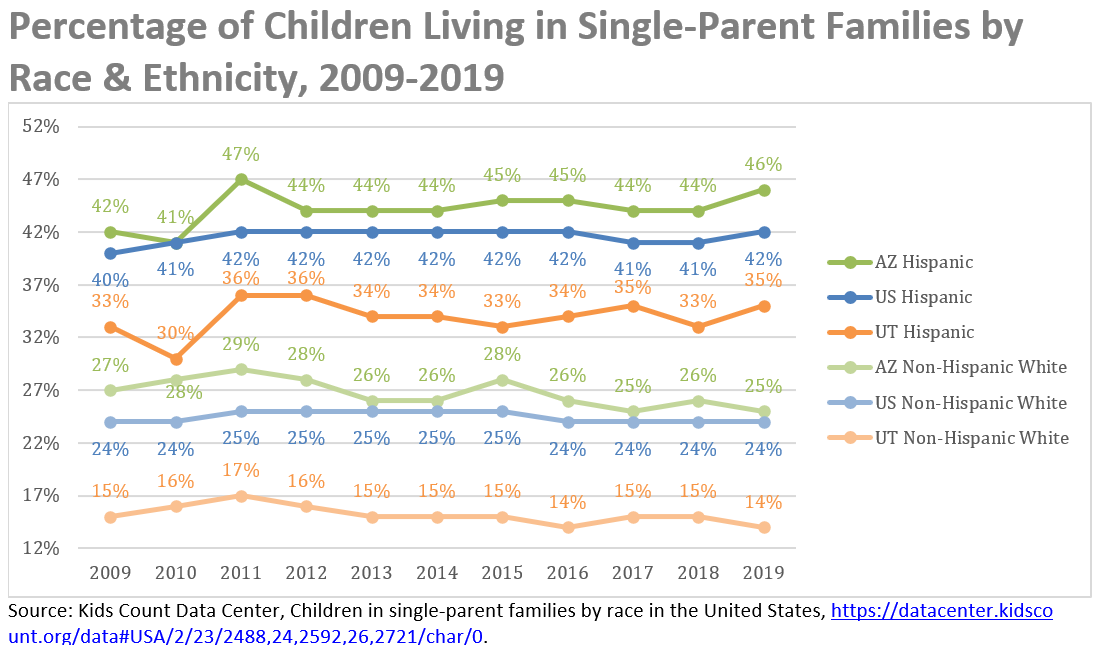
Educational Attainment: Utah Ahead of Arizona But Falling Behind the Nation
The charts below from our latest benchmarking report compare Utah, Arizona and the nation as a whole on educational attainment. Historically Utah was well ahead of the nation, but more recently evidence has mounted that the younger generation of Utahns is not keeping up with the nation's gains at the level of higher education. Moreover, there are stark racial/ethnic gaps in both states and the nation as a whole.
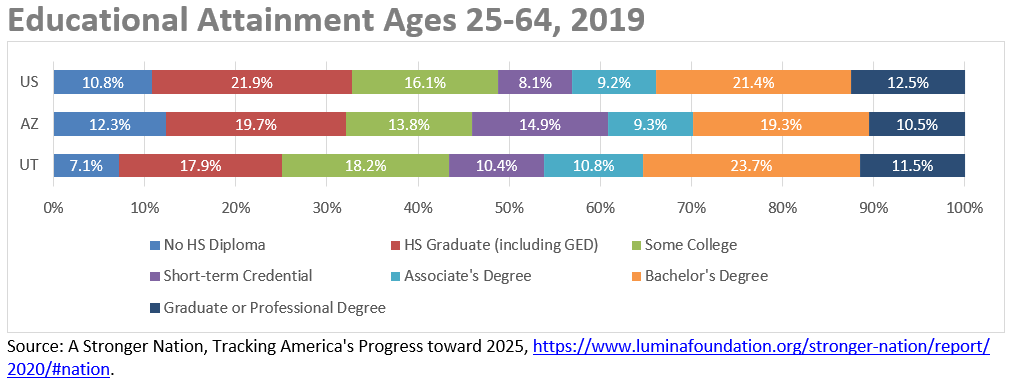
Utah's high school graduation rates are at or below national averages for most racial/ethnic categories, including our two largest groups, Whites and Latinos.
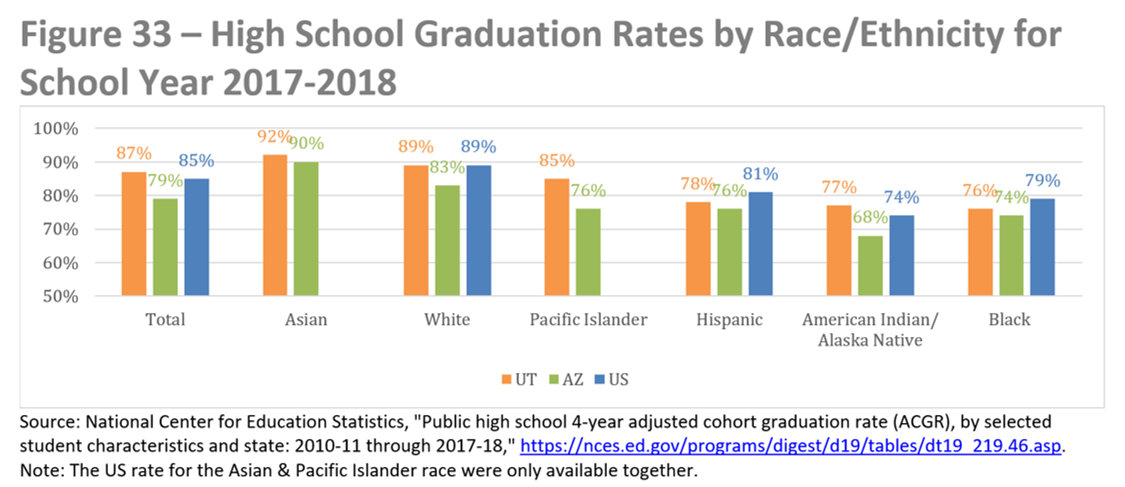
We're also very concerned that Utah's gap between high school graduation rates for Whites and Latinos is larger than nationally.
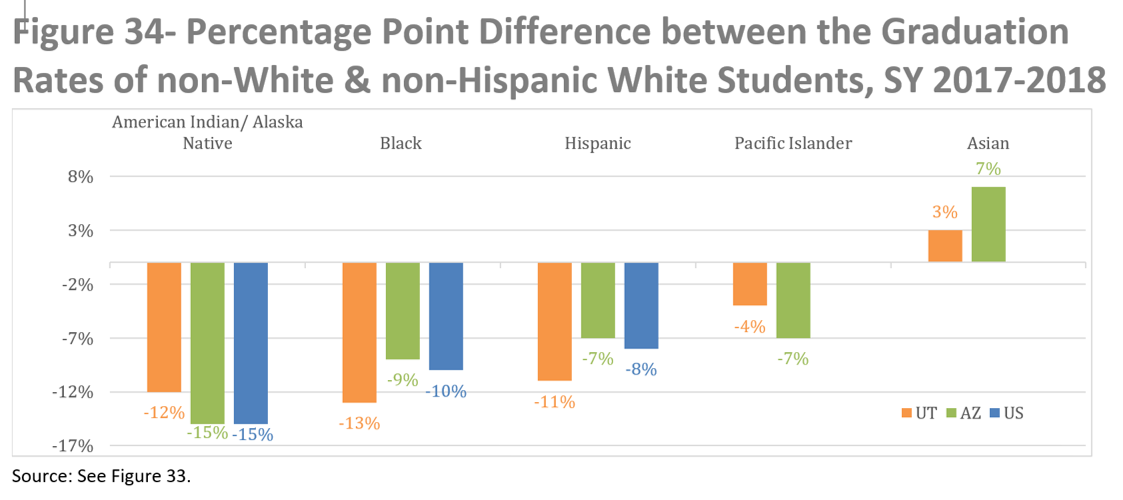
The chart below illustrates the way that Utah's younger generation of adults has fallen behind the higher education attainment of the Millennial generation nationally.
Can Utah Learn Any Lessons from Arizona's Strengths?
Besides Arizona's #11 rank for equal gender wage ratio (while Utah ranks #49), Arizona has more of its children in full-day kindergarten, has a lower 10th percentile hourly wage, and higher productivity. Arizona's higher 10th percentile hourly wage is likely due to their higher minimum wage, although they do have more people earning poverty level wages overall. Meanwhile, Utah has fewer people earning poverty level wages overall, but those at the 10th percentile for hourly wages earn less than their Arizonian counterparts.
Summary of Key Findings
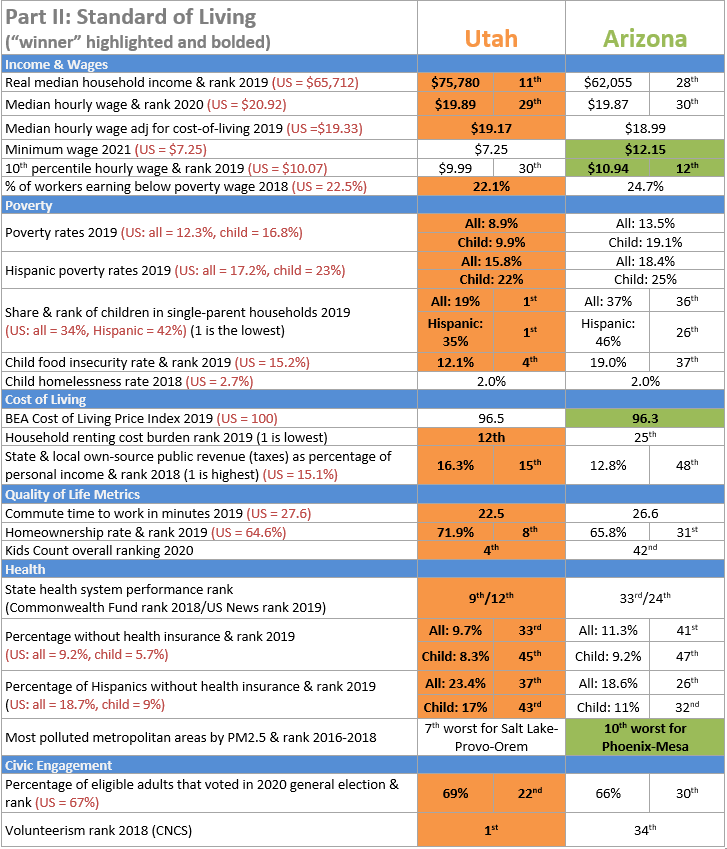
The full 56-page report is ![]() available here as a pdf download.
available here as a pdf download.
Policy Implications
Racial/Ethnic Gaps
Racial and ethnic gaps remain a major challenge in the nation overall, and Utah and Arizona are no exception. Disparities in Utah between minority racial & ethnic groups compared to their White non-Hispanic peers are evident in high school graduation rates, wages, gender pay gaps, poverty rates, and uninsured rates. Addressing these gaps through an upfront investment in education would likely increase educational attainment, wages, and standard of living overall and would therefore contribute to reducing racial and ethnic gaps in the future.
The Link Between Education and Income
The link between education and income is well-established. States with higher education levels generally have higher levels of worker productivity, wages, and incomes. In the current comparison with Arizona, Utah’s higher education levels make for higher levels of wages and income. The lesson for Arizona would be raise education levels to raise the state’s standard of living. The same applies to Utah, where the Legislature has struggled to turn seemingly large dollar increases in education funding every year into increases in real per-pupil investment sufficient to get Utah out of last place in the national ranking.
The latest data from the Census Bureau reports that Utah remains in last place in per-pupil education investment at $7,628, with Arizona only slightly better at $8,239 and 47th in the nation (for FY 2018). While Utah has done well for its meager investment levels, achieving impressive gains in educational performance as measured by NAEP 4th and 8th grade math and reading scores (see Figure 31, page 25), will we be able to continue to advance while remaining in last place?
While Utah “does more with less” in education compared to other states, we have growing challenges to address. Utah has racial/ethnic education gaps which are larger than the national average, for example for Hispanic and American Indian high school graduation rates (see Figure 33, page 26). Utah’s pupil-to-teacher ratio is 22.9, ranking 48th while the national average is 16 (see Figure 22, page 21). Moreover, Utah teacher pay has also fallen over the past 50 years by 1.8% while nationally teacher salaries have increased 6.7% (see figure 24, page 22).
At the college level, Utah historically was always ahead of the national average for attainment of bachelor’s degrees and above. But Census data show Utah’s lead shrinking relative to the nation with each successive generation, to the point now that Utah millennials (ages 25-34) are behind their peers nationally, despite relatively generous state support and low tuition levels.
Can Utah Become a High-Wage State?
For many years, economists have debated whether Utah is a low-wage state, as the Utah Foundation discussed in their 2008 report, “Is Utah Really a Low-Wage State?”[1] That report argued that our seemingly low wages were explained by our younger demographic profile and lower cost of living. While this report does not examine how wages intersect with age demographics, Utah ranks 29th in median hourly wages, compared to 41st in 2004 (see chart below). When adjusted for our low cost of living, Utah’s median hourly wage in 2019 was $19.17, just 16 cents lower than the national level. These data seem to demonstrate that Utah has gone from being a low-wage state a generation ago to middle-wage status today, a considerable accomplishment.

One question Utah leaders may now wish to consider is, is that good enough? Should we declare, “Mission Accomplished”? Or is Utah in a position, like Colorado and Minnesota before us, to become, over time, a high-wage state and set our sights on taking the necessary steps today to achieve that goal over the years and decades to come?
Similarly, how do we include those earning the lowest wages in the gains Utah has made and will potentially make in the future? Utah is not even a half percentage point lower than the national share of workers earning poverty level wages (see Figure 55, page 38) and lags behind the nation’s 10th percentile wage, ranking 30th (see Figure 54, page 37). Even as the state with the lowest income inequality ranking in the nation (see Figure 45, page 31), Utah suffers from a tremendous gap between low-income workers and the rest of the income scale.
The main lesson that emerges from the Working Families Benchmarking Project reports comparing Utah to Colorado, Minnesota, Idaho and now Arizona is the following: Higher levels of educational attainment translate into higher hourly wages, higher family incomes, and an overall higher standard of living. The challenge for policymakers is to determine the right combination of public investments in education, infrastructure, public health, and other critical needs that will enable Utah to continue our progress and achieve not just steady growth in the quantity of jobs, but also a rising standard of living that includes moderate- and lower-income working families from all of Utah’s increasingly diverse communities.
MEDIA COVERAGE OF THE BENCHMARKING PROJECT:
Facebook Live Event discussing the report overall joined by David Lujan, Director of Arizona Center for Economic Progress at Children's Action Alliance: https://fb.watch/68E_JarLMT/
Facebook Live Event focusing on women in higher education, the gender pay gap, and income equality with panelists: Dr. Susan Madsen, Founder and Director of the Utah Women & Leadership Project; Marshall Steinbaum Ph.D., Associate Professor at the University of Utah's department of Economics; and Gabriella Archuleta JPP MPP, Policy Analyst with YWCA Utah. https://fb.watch/68FoEVvGwY/
Facebook Live Event focusing on Utah's economic success and economic development strategy with panelists: Howard Stephenson MPA, former Utah Senator; Phil Dean MS MPA, public finance senior research fellow at the Gardner Institute; and Thomas Maloney PhD., Professor, Department of Economics, University of Utah. https://fb.watch/6r25O5rdDd/
Facebook Live Event focusing on education in Utah from pre-school to higher education, focusing on educational attainment & closing racial and ethnic gaps with panelists: Carrie Mayne, Chief Economist for Utah System of Higher Education; Andrea Rorrer PhD., Director of the University of Utah's Education Policy Center; and Anna Thomas MPA, Senior Policy Analyst at Voices for Utah Children. https://fb.watch/7iKYaR9Zy4/
What do Utahns Think About the Proposed Changes to Medicaid and PCN? Results of a Statewide Survey
Recently the Healthier Utah Coalition ‘Save Medicaid Campaign’ put together a survey to get public feedback on the Utah Department of Health’s proposed changes to its Medicaid program. The proposed amendments to the Medicaid and Primary Care Network (PCN) included controversial program changes such as lifetime caps on coverage, work requirements, and $25 copays for ‘inappropriate’ use of the ER. The proposed amendments would also eliminate presumptive eligibility in Medicaid and reverse an earlier Department of Health decision to restore comprehensive benefits to 19 and 20-year-old youth.
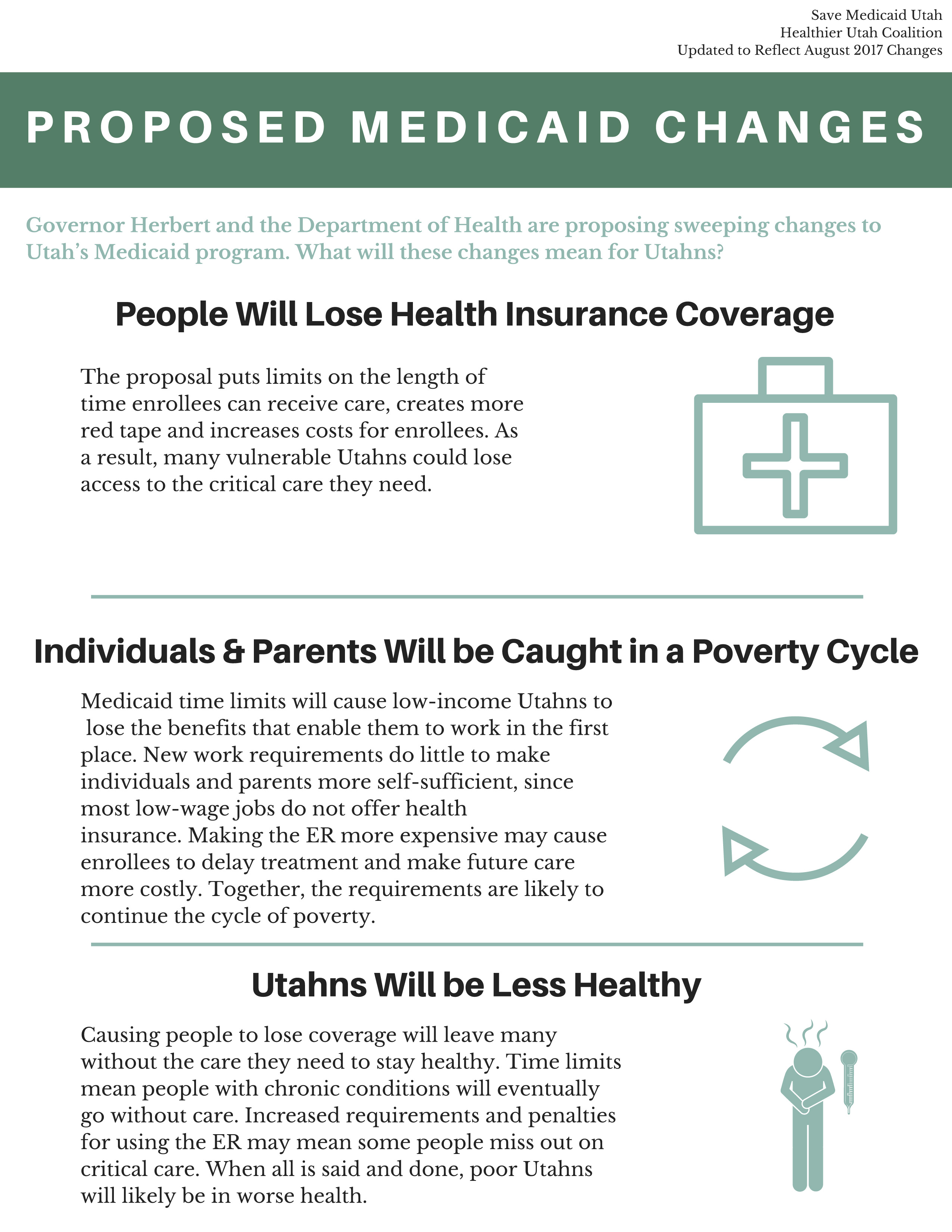
The Utah Department of Health held two public meetings at its Salt Lake City office in the summer. The Coalition’s survey was an attempt to reach a wider audience across the state, and walk through each amendment for those less familiar with the proposed waiver. We modeled the survey after a similar one developed by fantastic advocates in Kentucky. Survey responses were also sent to the U.S. Department of Health and Human Services, during their federal waiver comment period (if the respondent granted permission).
So, what did we learn?
Over 350 people took the survey. Survey respondents came from across Utah and all walks of life:
- Over half of respondents (58%) reported being either on Medicaid or PCN, or have a family member on Medicaid or PCN.
- The majority of respondents were between the ages of 30- 69.
- Over half of respondents (54%) were working less than 31 hours/ week. They reported working part-time, as a caregiver, or reported being retired, disabled or a student.
- 50% of respondents came from Salt Lake County, followed by Utah (11%), Davis (10%), Weber (8%), Washington (6%), Cache (3%), Iron (2%), and Box Elder (2%). Only six counties did not have any survey respondents: Daggett, Garfield, Juab, Kane, Morgan, and San Juan.
How did respondents feel about the proposed changes?
Overall, the proposed Medicaid changes were very unpopular. The most unpopular changes were imposing lifetime limits on PCN or Medicaid coverage. Interestingly, the option to impose ER penalties had the most support, although the majority of respondents still opposed it.
- 91% were against time limits on coverage
- 75% were opposed to work requirements
- 53% were opposed to ER penalties
- 87% opposed to eliminating presumptive eligibility
- 90% opposed eliminating comprehensive benefits for 19 and 20-year-old’s
A few of the comments from respondents:
“As a care taker for my elderly mother, I have been in this position for nearly a decade and my part time income is always below FPL, yet I cannot get inclusion into PCN because I have no children…. No one seems to be addressing people in my situation at all.”
“I am concerned that my adult daughter with significant health care issues may lose the critical coverage that she needs to sustain quality of life and even life itself.”
“Many of the families I work with cannot afford $25 dollars [for an ER copay]. Paying this much as a co-pay would mean they do not eat.”
“[Without Medicaid] I would have died from cancer by now. I'm 41. I have so many prescriptions for my illnesses, I would be bankrupt and homeless, relying on hand outs. Now I have a part time job, housing I can pay rent and utilities bc my medical is covered. I know hundreds of people in my community who are receiving mental health care like myself. It's the best around. I am grateful daily as I am healthy only bc I have adequate health services. I can't imagine if I didn't. I would suffer severely. Many Utahns are in the same situation.”
For 30 years now, Voices for Utah Children has called on our state, federal and local leaders to put children’s needs first. But the work is not done. The children of 30 years ago now have children of their own. Too many of these children are growing up in poverty, without access to healthcare or quality educational opportunities.
How can you be involved?
Make a tax-deductible donation to Voices for Utah Children—or join our Network with a monthly donation of $20 or more. Network membership includes complimentary admission to Network events with food, socializing, and opportunity to meet child advocacy experts. And don't forget to join our listserv to stay informed!
We look forward to the future of Voices for Utah Children and we hope you will be a part of our next 30 years.
Special thanks to American Express, our "Making a Difference All Year Long" sponsor. 


